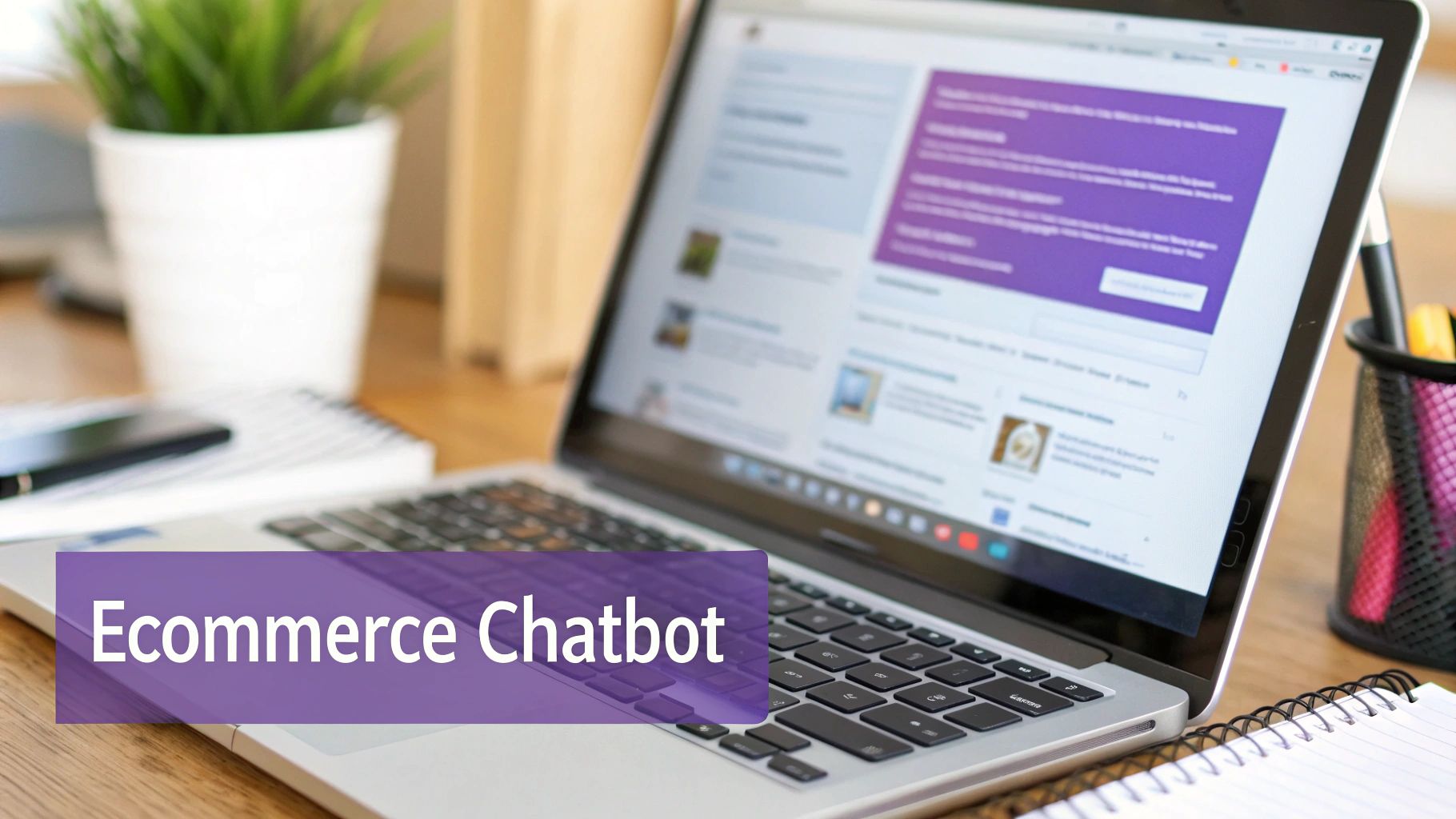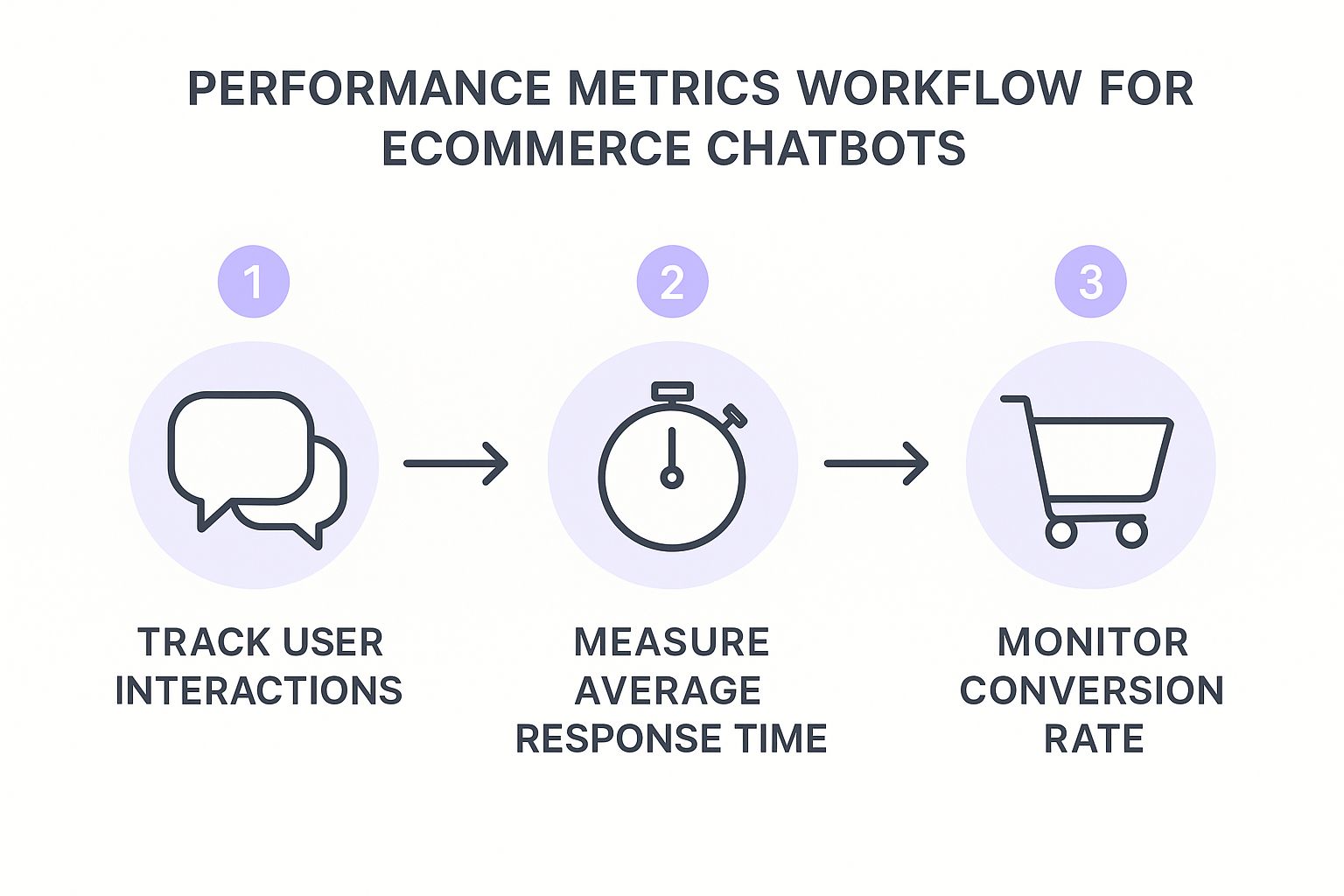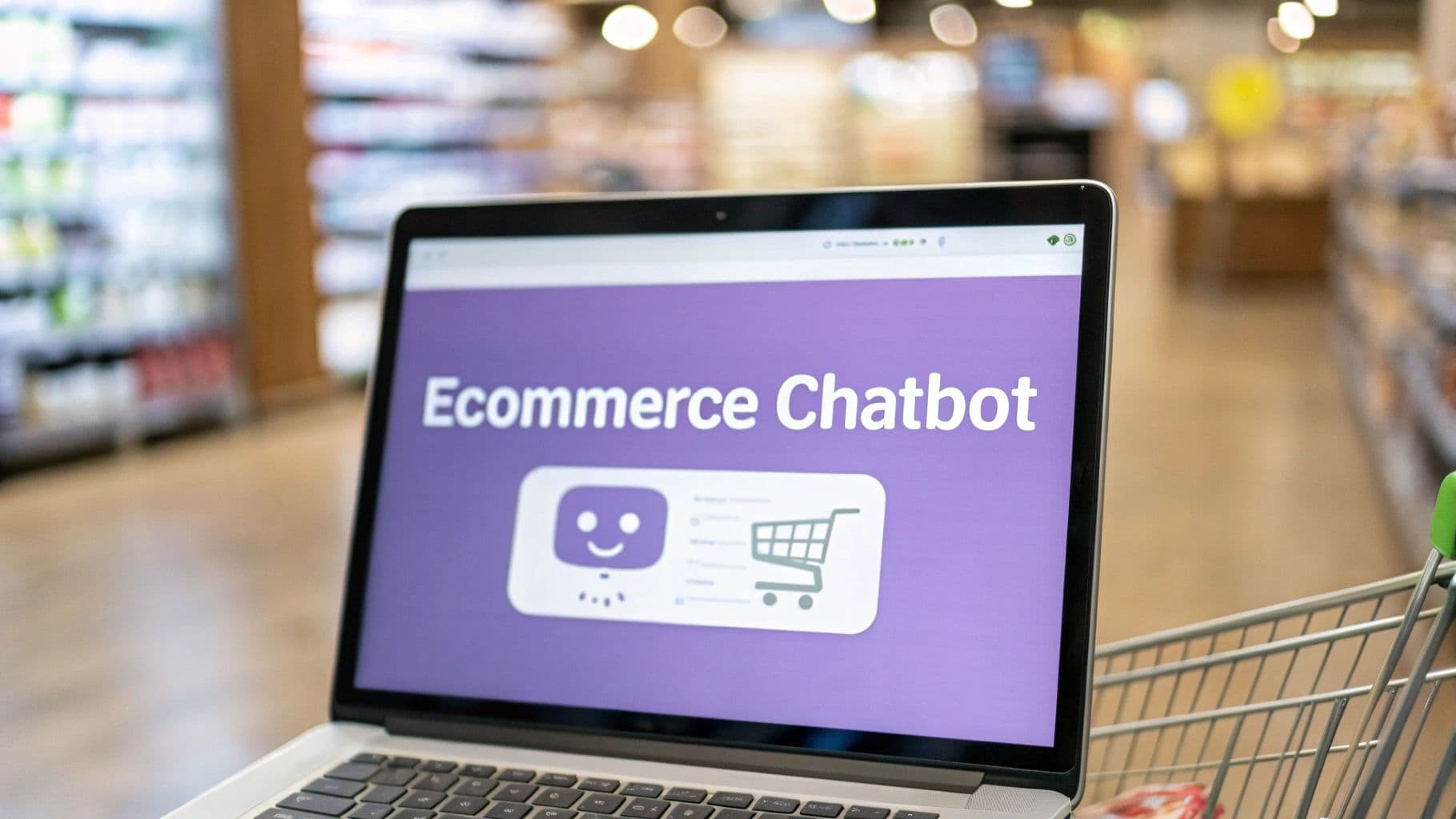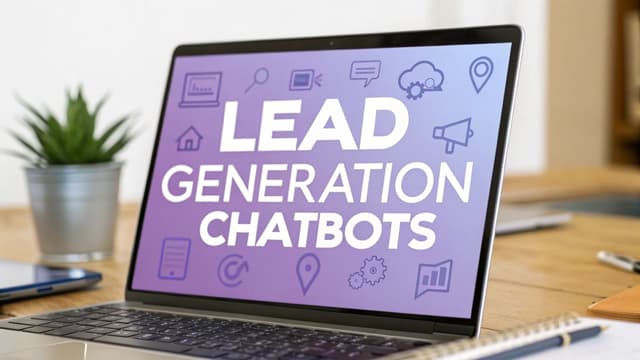Imagine having a brilliant sales assistant on your site 24/7. One who never gets tired, never needs a coffee break, and is always ready to help every single visitor. That’s exactly what a modern chatbot for ecommerce brings to your online store. It's a smart AI tool that acts as both a virtual salesperson and a support agent, smoothing out the path from discovery to purchase for your customers.
Meet Your New Best Salesperson

Think of an ecommerce chatbot as the most diligent employee you could ever hire. It greets every visitor, answers their questions in an instant, and guides them toward the perfect product without fail. This isn't just some clunky pop-up window with pre-written answers; it’s a strategic asset built to completely change how customers interact with your store.
These AI tools are designed to handle the entire customer journey, and they can do it at an incredible scale. They offer immediate support and personalized recommendations, turning casual browsers into loyal, paying customers.
The Role of Chatbots in Modern Retail
In the cutthroat world of online retail, customer experience is king. Shoppers today have high expectations—they want quick answers and a shopping experience that feels effortless. An ecommerce chatbot is designed to meet these expectations by being present at every crucial step of their journey.
A chatbot’s primary mission is to remove friction. Whether a customer is trying to find a specific size, track an order, or understand a return policy, the bot provides an instant resolution, preventing frustration and potential abandonment.
This immediate assistance is a real game-changer. Instead of making customers dig through FAQ pages or wait hours for an email reply, the chatbot delivers the right information, right when they need it. The knock-on effect on your business metrics can be massive.
Ecommerce chatbots are becoming essential for improving how online stores operate and talk to customers. In fact, market analysis shows that 30% to 40% of all chatbot use is in online retail, where they act as virtual shopping assistants. By guiding shoppers through their purchase decisions, these bots can slash cart abandonment and boost conversion rates by up to 25%.
To get a better sense of what a chatbot can do, here’s a quick breakdown of its core functions.
Key Functions of an Ecommerce Chatbot
| Function | Impact on Business |
|---|---|
| Instant Customer Support | Resolves common queries 24/7, reducing support tickets and wait times. |
| Product Recommendations | Suggests relevant products based on user behavior, increasing average order value. |
| Order Tracking & Status | Provides real-time updates on orders, improving customer satisfaction. |
| Lead Generation | Captures contact info from visitors, growing your marketing list. |
| Cart Abandonment Recovery | Re-engages users who leave items in their cart, recovering lost sales. |
These functions work together to create a much smoother, more engaging shopping experience while taking a significant load off your team.
More Than Just Customer Support
While handling customer questions is a huge part of their job, the true power of an ecommerce chatbot is its ability to proactively drive growth.
It's not just sitting there waiting for a question. A well-designed chatbot can:
- Proactively Engage: It can start conversations with visitors, offering help or pointing out special deals, much like a helpful associate in a physical store.
- Offer Personalized Recommendations: By looking at what a shopper is browsing, it can suggest other products they might love, making a sale more likely.
- Generate Leads: For visitors who aren't quite ready to buy, the chatbot can ask for an email address to keep them in the loop with future marketing.
By automating these key tasks, a chatbot frees up your human team to tackle the more complex, high-value problems that require a human touch. For a deeper dive into the specifics, check out our guide to leveraging an AI chatbot for e-commerce. Ultimately, it’s not about replacing people—it’s about empowering them to do their best work.
How Ecommerce Chatbots Actually Work

It can feel like a bit of magic when a chatbot instantly understands your question and fires back the perfect answer. But behind the curtain, it's a blend of powerful, interconnected technologies that make it all happen. Once you peek under the hood, you’ll see why modern bots are so incredibly effective.
Before we get into the nuts and bolts, it helps to have a baseline understanding of the definition of chatbots.
Think about it like teaching a kid how to talk. You start with the basics—simple, fixed rules. If someone gives you a cookie, you say, "Thank you." This is the classic rule-based chatbot. It operates on simple scripts triggered by specific keywords.
A customer types "track order," and the bot, seeing that exact phrase, follows a pre-written path to ask for an order number. It's functional, sure, but it's also rigid. A typo, some slang, or a slightly different question can throw it for a loop, just like a toddler getting confused by a complex sentence. This is where the real intelligence comes in.
The Power of AI and NLP
To get beyond those clunky, scripted conversations, a modern chatbot for ecommerce leans on Artificial Intelligence (AI). More specifically, it uses a branch of AI called Natural Language Processing (NLP). This is the tech that lets a bot read, understand, and figure out what a human is actually saying, in all its messy, unpredictable glory.
It’s the leap from a child repeating "thank you" to an older kid understanding the idea of gratitude. Armed with NLP, a chatbot can grasp a user's intent, even if they word their question in a weird way. For instance, the bot learns that all of these questions are really asking the same thing:
- "Where is my stuff?"
- "Can I get a shipping update?"
- "Status on order #12345?"
- "When will my package arrive?"
NLP breaks down the sentence, picks out the important parts (like an order number), and deciphers the underlying goal. This makes the conversation feel natural and flexible, leaving the customer feeling heard and understood.
Machine Learning: The Brain That Gets Smarter
So, if NLP is about understanding language right now, Machine Learning (ML) is what allows the chatbot to learn and get better over time. It's a type of AI where the system sifts through tons of data to find patterns and make predictions, all without someone having to manually program every single possibility.
Every conversation your chatbot has becomes a learning opportunity. It analyzes which answers solved a problem and which ones led to a dead end or a frustrated customer. Over time, it refines its responses to become more accurate and helpful.
This is how a chatbot "grows up." Just like a person learns from social cues and past interactions, an ML-powered bot learns from every single customer chat. It gets better at decoding slang, anticipating what a customer might ask next, and even sensing frustration. This constant feedback loop is what separates a decent chatbot from a truly great one, turning it into an asset that gets smarter every day.
Here is the rewritten section, crafted to sound like an experienced human expert and match the provided examples.
The Core Benefits of Using a Chatbot
Putting a chatbot for ecommerce to work isn't just a neat tech upgrade; it's a direct path to tangible business growth. Think of these AI assistants less as simple support tools and more as powerful engines that boost revenue, earn customer loyalty, and make your entire operation run more smoothly.
The proof is in the numbers. The global chatbot market is already valued at roughly $15.57 billion and is expected to explode to $46.64 billion by 2029. With over 987 million people already using them, it's clear this isn't a fleeting trend. This boom is fueled by ecommerce businesses realizing chatbots are the key to offering 24/7 service and simplifying the path to purchase.
Let's break down the core advantages you can actually expect to see.
Drive More Sales and Conversions
An ecommerce chatbot is like having a proactive sales assistant on your site, ready to engage every single visitor at just the right moment. It doesn't just sit there waiting for questions. It starts conversations that guide shoppers toward a purchase, directly impacting your bottom line.
This kind of proactive engagement works in a few key ways:
- Upselling and Cross-selling: Imagine a customer adds a new camera to their cart. The chatbot can immediately pop up and suggest a compatible memory card or a protective case. Just like that, you've increased the average order value with zero extra effort.
- Personalized Recommendations: By looking at a shopper's browsing history, the bot can showcase products they're genuinely likely to love. This isn't generic advertising; it's a personalized shopping experience that feels helpful and drives conversions.
- Recovering Abandoned Carts: When a shopper gets distracted and leaves items in their cart, the chatbot can send a friendly reminder. Sometimes, it can even offer a small, strategic discount to nudge them over the finish line, saving a sale that would have been lost.
Elevate the Customer Experience
In the world of online retail, speed and availability are everything. Customers want answers now, not tomorrow. A chatbot delivers exactly that, around the clock. This instantly transforms the customer experience from potentially frustrating to completely seamless.
A chatbot ensures no customer is left waiting. Whether it's 3 AM on a holiday or the middle of a massive sales event, your store is always "on," ready to help, track orders, and solve problems instantly.
This kind of immediate, always-on support builds incredible trust and satisfaction. When customers know they can get help with order tracking or return policies without waiting in a queue, they feel valued. That feeling is what brings them back, turning them from one-time buyers into loyal fans. You can learn more about this in our comprehensive guide to using a chatbot in ecommerce.
Boost Your Operational Efficiency
Let's be honest: repetitive questions eat up a massive amount of your support team's time and energy. A chatbot automates thousands of these routine inquiries, from "Where is my order?" to "What's your return policy?" This frees up your human agents to handle the complex, high-value work that truly requires their expertise.
This automation directly slashes your operational costs and improves team morale. Your support staff can finally stop copy-pasting answers and instead focus on tasks that need critical thinking and a human touch, like handling a tricky return or giving a high-value customer some extra attention. The result is a more efficient, motivated, and effective team.
Uncover Powerful Customer Insights
Every single conversation a chatbot has is a piece of data. Taken together, these chats are a goldmine of information about what your customers really want, what their biggest frustrations are, and which products are sparking the most interest.
By analyzing chat logs, you can quickly spot:
- Common questions that signal a need to improve your product descriptions or FAQ page.
- Friction points where shoppers get stuck or confused in the buying journey.
- Emerging trends in what customers are asking for or searching for on your site.
This data isn't just interesting—it's actionable. It allows you to make smarter, data-driven decisions to improve your website, your products, and your overall strategy. In fact, implementing a chatbot aligns with many of the top e-commerce best practices for growing your revenue.
Essential Features Your Chatbot Needs

Choosing the right chatbot for ecommerce can feel overwhelming. You're hit with a wall of technical jargon and bold promises. But here’s the thing: not all bots are created equal, and the features you pick will make or break its success.
Think of this as your buyer's guide—a simple checklist of the absolute must-haves. This isn't just about finding a tool that can answer a few questions. It's about getting a solution that actually plugs into your business, helps customers wherever they are, and gives you data you can actually use. Get this wrong, and you'll end up with a bot that just creates more headaches.
Foundational Technical Capabilities
Before you even think about what the chatbot will say, you need to make sure it has a rock-solid technical foundation. These are the behind-the-scenes features that allow the bot to work smoothly with the tools you already use and reach all your customers.
- omnichannel communication strategy: Your customers aren't just on your website. They're scrolling through Instagram, chatting on Facebook Messenger, and sending messages on WhatsApp. A great chatbot has to be everywhere they are, offering the same helpful experience no matter the platform.
- Seamless Integrations: The chatbot can't be a silo. It needs to talk directly to your other business systems—your CRM, your helpdesk software, and especially your ecommerce platform (like Shopify or Magento). This is how it can look up an order status, update a customer's profile, or create a support ticket on the fly.
- Powerful Analytics Dashboard: You can't fix what you can't see. A solid analytics dashboard is non-negotiable for tracking what’s working. You need clear data on things like how many people are using the bot, how many problems it's solving, and what questions customers are asking the most.
These technical pillars are what make your chatbot a core part of your operations instead of just a flashy add-on.
Essential Conversational Features
Once the technical guts are in place, it’s all about the conversation itself. This is what separates a helpful, smart assistant from a clunky, robotic script-follower. A truly great bot does more than just wait for a prompt.
The goal is to create an experience that feels like a natural conversation with a knowledgeable assistant. This means the chatbot needs tools to guide, persuade, and gracefully handle situations it can't solve on its own.
Look for a platform that gives you a suite of tools designed to make the user's journey better and, ultimately, drive more sales.
Here are the conversational features you can't skip:
- Proactive Messaging: A smart bot doesn't just sit there. It should be able to jump in and start a conversation based on what a user is doing—like if they're stuck on a product page for a while or look like they're about to abandon their cart.
- Visual Product Carousels: They say a picture is worth a thousand words, and in ecommerce, it's worth a sale. The bot should be able to show off your products in a scrollable carousel right inside the chat. This lets customers browse and buy without ever leaving the conversation.
- Smooth Human Handoff: Let's be real: no bot can handle everything. When a problem gets too complex or a customer gets frustrated, the chatbot needs to pass the conversation to a real person. Critically, it must hand over the entire chat history so the customer doesn't have to repeat themselves.
Chatbot Feature Comparison: Rule-Based vs AI-Powered
Finally, you need to understand the "engine" running your chatbot. The underlying technology dictates how smart, flexible, and useful it can be. The two main flavors—rule-based and AI-powered—are worlds apart in what they can do.
Choosing between them often comes down to your immediate needs versus your long-term goals. A simple, rule-based bot can handle basic tasks, but an AI-powered one can grow with your business and handle much more complex interactions.
Here’s a quick breakdown to help you decide.
| Feature | Rule-Based Chatbot | AI-Powered Chatbot |
|---|---|---|
| Flexibility | Follows strict, pre-defined scripts. Fails if users deviate. | Understands user intent, context, and slang. Adapts to conversation. |
| Learning | Static. Requires manual updates to improve. | Learns from every interaction, becoming smarter and more accurate over time. |
| Setup | Simpler to set up for basic FAQs. | More initial training needed, but offers far greater long-term value. |
| Best For | Very simple, predictable tasks like checking business hours. | Dynamic conversations, personalized recommendations, and complex support. |
For any ecommerce business looking to scale, an AI-powered chatbot is almost always the right call. Its ability to understand natural language and actually learn from interactions makes it a valuable asset that gets better over time, right alongside your store.
Implementing Your First Ecommerce Chatbot
Bringing your first chatbot for ecommerce to life is an exciting step. It's not about just flipping a switch, though. With a clear roadmap, you can skip the common headaches and launch a tool that delivers real value from day one.
The journey doesn't start with code or fancy tech—it starts with your goals. A thoughtful process of aligning the technology with what your business actually needs is what separates a successful bot from a frustrating one.
Step 1: Define Your Business Goals
First things first, you have to ask: What specific problem am I trying to solve here? A vague goal like "improve customer service" won't cut it. You need concrete, measurable targets that tell you whether this thing is actually working.
Think in terms of tangible outcomes:
- Reduce cart abandonment by 15% by proactively helping shoppers who seem stuck at checkout.
- Cut down support ticket volume by 30% by automating the top 10 most common customer questions.
- Boost lead generation by 20% by grabbing email addresses from visitors who browse but don't buy on their first visit.
These key performance indicators (KPIs) become your North Star, guiding every decision you make, from the words the bot uses to the platform you choose.
Step 2: Map Key Customer Journeys
With your goals set, it's time to figure out exactly which customer interactions to hand over to your bot. Think about the most repetitive, high-volume tasks that tie up your team. Where do customers get stuck most often? Where can a bot make the biggest impact, fast?
You don't need to automate everything at once. Start small and focus on a few critical pathways. Good starting points usually include:
- Order Tracking: Answering "Where is my order?" is often the single biggest win. It frees up your human support team for more complex issues.
- Product Discovery: A bot can act like a personal shopper, guiding users to the right product based on size, color, or what they need it for.
- Returns and Exchanges: Giving instant, clear instructions on how to handle a return can turn a potentially negative experience into a smooth one.
Mapping these out helps you build a bot that solves real problems right out of the gate.
Step 3: Craft a Chatbot Persona
Your chatbot is an extension of your brand, so it needs a personality. It should speak in a voice that matches how you talk to customers everywhere else—on your site, in your emails, and on social media. Is your brand playful and witty? Or is it more professional and straight-to-the-point?
A well-defined persona is what keeps your chatbot from feeling like a cold, robotic script. It creates a consistent brand experience and makes the conversation feel more natural and memorable for the customer.
Give your bot a name, maybe an avatar, and a clear tone of voice. It's a small detail that makes a huge difference in how customers perceive your bot and, by extension, your entire brand.
Step 4: Build and Test Conversational Flows
Now you get to the fun part: building the actual conversations. Start with the key journeys you mapped out and create logical, step-by-step scripts. Your existing support chat logs and FAQs are a goldmine here—they're filled with the real language your customers use and the exact problems they face.
The infographic below shows the essential metrics you'll want to track to see how well your chatbot is performing.

As the workflow shows, success isn't just about how many people talk to the bot; it's about efficiency and its real impact on your bottom line. Testing is absolutely critical. Have your own team, and maybe even a small group of loyal customers, try to break it. Find the awkward phrases, dead ends, and broken logic before it goes live. For a deeper dive, check out our complete guide on implementing a chatbot.
The market for these tools is exploding for a reason—the results are tangible. Its value is projected to skyrocket from $5.4 billion in 2023 to $15.5 billion by 2028. To get ahead of the curve, you can explore more about these 2025 e-commerce AI chatbot trends and see where the industry is headed.
Common Questions About Ecommerce Chatbots
Even with all the benefits laid out, it’s completely normal to have a few nagging questions before bringing a new tool into your business. A chatbot for ecommerce is a pretty big step, and you want to be sure it's the right one for your brand. This section gets right to the point, tackling the most common worries and "what ifs" we hear from business owners just like you.
Our goal is to give you straightforward, practical answers so you can make a decision with confidence. We’ll cut through the jargon and address the real-world questions about cost, complexity, and that big one: whether a bot will make your brand feel less human.
Will A Chatbot Make My Brand Feel Too Robotic?
This is probably the number one concern we hear, and it’s a fair one. The short answer is no—not if you build it with care. The secret is to design a chatbot persona that actually reflects your brand's unique voice. A bot doesn't have to be a cold, generic robot; it can be just as witty, helpful, and professional as your best team member.
Today's AI is much better at understanding context and even sentiment, which allows for surprisingly natural conversations. But the best strategy is almost always a hybrid model.
Use your chatbot for what it's great at: answering routine, predictable questions in a flash. But the moment a problem gets complicated or a customer is clearly getting upset, the bot should know to seamlessly hand the conversation over to a human.
This approach gives your customers the best of both worlds. They get instant answers for simple things and the empathy of a real person for bigger issues. This doesn't make your brand feel robotic; it makes it feel incredibly responsive and helpful.
How Much Does An Ecommerce Chatbot Cost?
The cost can swing wildly, and it really comes down to what you need it to do. There's no single price tag.
- Simple, rule-based bots are very affordable. Many platforms have free starter plans or paid options that kick in at around $50 per month. These are perfect for handling basic FAQs.
- More advanced, AI-powered chatbots that integrate deeply with your other systems can cost anywhere from a few hundred to several thousand dollars a month. These bots are much more powerful, capable of learning from conversations and managing complex requests.
The price is mainly shaped by how many customer conversations you have each month, how complex your sales or support flows are, and the level of custom branding you want. It's helpful to think of the cost as an investment. Stack it up against the potential return from lower support costs and more converted sales.
How Much Technical Skill Do I Need To Set One Up?
Honestly, far less than you probably imagine. The days of needing a developer on speed dial to build a basic bot are over. Most modern chatbot platforms are designed for regular business users, not programmers. They almost all feature intuitive, no-code visual builders.
These tools typically use a drag-and-drop interface, letting you:
- Map out conversation flows visually.
- Set up rules for when the bot should pop up.
- Tweak the bot's look and feel to match your website.
You can create, launch, and manage a really effective chatbot without ever touching a line of code. Sure, if you want to build highly advanced custom features or connect to a unique internal API, you might need a bit of technical help. But for the vast majority of ecommerce stores, it's a DIY job.
Ready to deliver instant, human-quality support and boost your sales? The FlowGent AI platform makes it simple to deploy intelligent AI agents across all your customer channels. Start scaling your customer service today.


